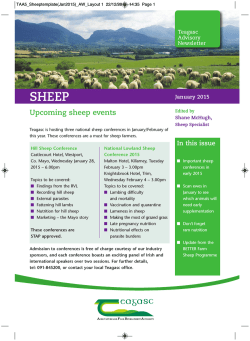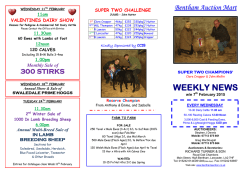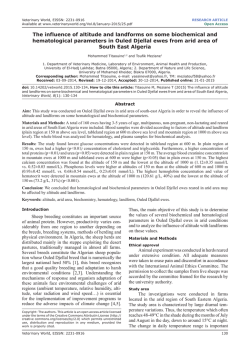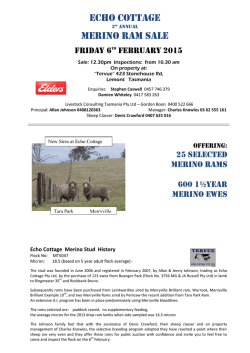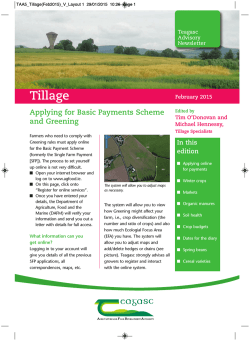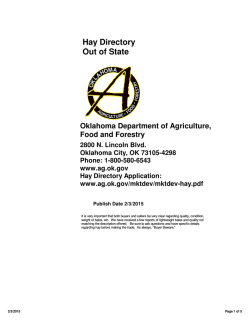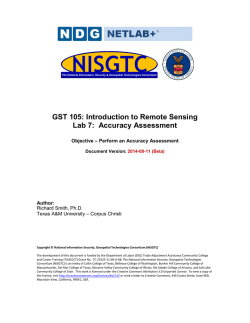
sheep - Teagasc
TAA5_Sheeptemplate(Feb2015)_AW_Layout 1 29/01/2015 11:48 Page 1 Teagasc Advisory Newsletter SHEEP February 2015 Grassland management Edited by The relatively mild winter has led to significant quantities of grass on fields that were closed up last autumn. This grass will be welcomed by the freshly lambed ewe flocks in the coming months, but the challenge will be to keep grass growing and to provide sufficient high quality grass for the ewes during March and April. February is the time to start considering spreading fertiliser or slurry to boost spring growth. Any fertiliser/slurry applied will facilitate growth when environmental conditions are conducive to grass growth. Once soil temperatures reach 6oC, and provided that ground conditions are suitable for a tractor to travel, then the first application of chemical fertiliser should be made. Where soil samples indicate that there is a deficiency of phosphorus (P), potassium (K) or lime, this Head of Sheep Michael Gottstein, Programme In this issue Once soil temperatures reach 6oC, and provided that ground conditions are suitable for a tractor to travel, the first application of chemical fertiliser should be made. should also be rectified. Failure to do this will result in much of the fertiliser being applied ending up locked in the soil and useless to the grass plant. Remember that if you apply ground limestone, you cannot use urea fertiliser for a period of four to six months afterwards. Check the weather forecast, as there is no point in spreading chemical fertiliser if there is heavy rain forecast for the following 48 hours. n Grassland management n Late pregnancy nutrition n Flock healthcare n Scanning telling a good story n Pre-lambing feeding regime n Prevent crushing TAA5_Sheeptemplate(Feb2015)_AW_Layout 1 29/01/2015 11:48 Page 2 SHEEP Late pregnancy nutrition energy value of the various ingredients are listed in the table below. Pregnant ewes need high quality concentrate feed that consists of high and medium quality energy inputs and a good quality protein source. Similar to last year, indications from farmers and scanners are that sheep have scanned very well this year and that litter size is up on most farms. Make sure you adjust your feeding routine to take account of this. Ewes with multiples (twins, triplets and quads) should be segregated and fed according to litter size. Ewes with triplets and quads should have been started on concentrate feed eight to ten weeks out from lambing depending on forage quality. Look at the ingredients in your sheep feed. Pregnant ewes need high quality concentrate feed that consists of high and medium quality energy inputs and a good quality protein source. The best protein source is soyabean meal and the Table 1. Guide to energy contents per kg as fed in feedstuffs commonly used in sheep rations UFL High Maize 1.05 energy Distillers grain, maize 1.03 Soya bean meal, hi pro 1.02 Citrus pulp 1.01 Barley 1.00 Unmolassed sugar beet pulp 1.01 Wheat 0.99 Medium Maize or corn gluten feed 0.92 energy Soya hulls 0.91 Oats 0.89 Rapeseed meal 0.88 Low Palm kernel meal (expeller) 0.86 energy Cotton seed meal (extracted) 0.83 Cane molasses 0.76 Pollard/wheat feed meal 0.70 Grass meal (imported) 0.60 Sunflower meal 25% CP 0.59 Good hay 85%DM, 60DMD, 0.59 (Source: O’Mara, 2000) All concentrate feed should be balanced for vitamins and minerals. Flock healthcare Clostridial vaccinations are due four to six weeks pre lambing. In most situations these should be given four weeks before the target lambing date for first ewes in the flock. Don’t forget to give the rams and any replacement ewe lambs a booster shot at this time also. Clostridium sordellii is becoming more common as a cause of sudden death in sheep. It is not covered by the eight-in-one vaccines, so if you have had a problem with this you should consider using one of the 10-in-one vaccines. The full two-shot primary course will be required to ensure that the sheep have adequate protection. TAA5_Sheeptemplate(Feb2015)_AW_Layout 1 29/01/2015 11:48 Page 3 FEBRUARY 2015 BETTER FARM UPDATE Scanning telling a good story Ciaran Lynch, Animal and Grassland Research and Innovation Centre, Teagasc Athenry, Co. Galway, reports on latest progress. The lowland flocks will be gearing up for another round of lambing. However, they are also planning for another grazing season. Each of the farmers, along with their advisers, will examine their soil results from previous years and plan out their fertiliser and, in some cases, lime applications for 2015. Early lamb flocks Lambing went well for John Doyle’s, Tomas O’Leary’s and Peadar Kearney’s early lambing ewes. Although conditions were difficult during January, the flocks in Wexford and Louth got the ewes turned out onto pasture that was rested up from the previous late September/early October. These ewes are being supplemented post turnout at a rate of 0.5 to 0.75kg until the lambs are consuming sufficient amounts of concentrate themselves. The farm in Kerry, as in previous years, is maintaining the flock indoors. This is a trade off as the demand for early spring grass will be greater in early March for this midseason flock and beef enterprise. Here ewes rearing twins are receiving 1.5kg of concentrate per day alongside high quality forage. Mid-season flocks With scanning complete in January for the remaining flocks, the farmers can now better meet the nutritional demands of the ewes. The scan results have improved this year for individual flocks, and the results for the eight lowland flocks are summarised in Table 2. There was a big improvement in scan for the five farmers with ewe lamb flocks, as summarised in Table 3. These lambs were heavier this season going to the ram and in turn have scanned with a better crop. On average the scanning rate is 0.36 lambs higher this year. Each of these flocks has been supplementing these lambs since January and will now supplement those with multiples accordingly. Hill flocks The hill flocks in the programme will gather the ewes this month for scanning. At this stage the flocks will be split into those carrying twins and singles for feeding purposes. Some of the thinner ewes carrying singles will also be retained with the twin ewes to receive extra supplementation. Table 2. Mid-season flocks scan results Scanned litter size Scanned pregnancy rate Scanning rate Average 2.01 96.8 1.95 Table 3. Scanning results for the ewe lamb flocks O’Connell Spillane Leitrim Tipperary Scanned litter size 1.44 1.57 Scanned pregnancy rate 90.0 93.8 Scanning rate 1.30 1.48 Range 1.83-2.2 92.7-100 1.78-2.16 Nicholson Kilkenny 1.58 84.8 1.34 Doyle Wexford 1.67 83.8 1.40 O’Leary Kerry 1.61 92.5 1.49 TAA5_Sheeptemplate(Feb2015)_AW_Layout 1 29/01/2015 11:48 Page 4 SHEEP RESEARCH UPDATE Pre-lambing feeding regime Philip Creighton, Animal and Grassland Research and Innovation Centre, Teagasc Athenry, Co. Galway. Ewes were scanned in early January. Preliminary analysis shows a scan rate of 1.78 in the medium prolific flocks with the high prolific groups averaging 2.10. Stocking rate has had little effect on scanned litter size, which is an improvement on last year when the 14 ewe/ha stocking rate groups had a lower litter size compared to the 10 and 12 ewe/ha stocking rates. Ewes are in good body condition averaging 3.3 BCS. The 10 ewe/ha stocking rate groups were housed in mid January. Ewes are now being offered grass silage (73 DMD) and have been grouped according to scanned litter size and lambing date as predicted by raddle colour, which was changed weekly during mating, and will be offered concentrates as shown in Table 4. Over winter grass growth rates have been in the region of 3-5kg DM/ha/day and so grass + covers on the first paddocks closed are now in the region of ~700-900kg DM/ha (6-7cm). Nitrogen in the form of urea will be blanket spread on all farmlets at a rate of 23 units/ac (half bag) once soil temperatures are above 67oC in early to mid February to help boost grass covers prior to turnout in March. The pre-lambing clostridia booster will be administered in mid February ahead of a lambing start date of March 6. Table 4. Feeding regime for ewes pre lambing Weeks pre lambing 7 6-5 4-3 2-1 Total Concentrates (kg/ewe/day) Singles – – 0.3 0.6 13 Twins – 0.35 0.55 0.75 23 Triplets 0.2 0.35 0.65 0.95 29 HEALTH & SAFETY February is a month where considerable yard work is carried out. Some 60% of farm workplace deaths in Ireland were associated with farm vehicles, with the majority involving crushes or blows in the farmyard. Being crushed at the lungs is particularly dangerous because the victim of the accident cannot breathe. Adopting safe behaviour as a routine is the key to preventing this type of accident. Stop the tractor safely, make the load safe and, in particular, apply the handbrake. For further information on any issues raised in this newsletter, or to access other enterprise newsletters, please contact your local Teagasc adviser or see www.teagasc.ie. Produced by Think Media. Prevent crushing
© Copyright 2025
